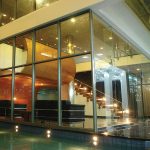-
Havelock City: New Urbanism in Colombo
March 2008
Most cities in Asia are synonymous with density, with a high concentration of people and buildings within a small area. This density is sometimes planned, as it helps to effectively use resources such as transportation and other public services – the closer we are to such amenities, the lower the cost of its provision and the increase in its use.
But this very density can sometimes be overwhelming. It saps all sense of individuality, and it often reduces an individual to a statistic, a mere number in a larger whole.
The American movement of ‘New Urbanism,’ which originated in the 1980s, can be seen as a reaction to such trends that threaten the survival of distinct local community cultures. New Urbanism is often recognised as an argument for ‘high density development’ as opposed to the ‘sprawling megalopolis’ that characterises contemporary city development. Spread of low density urban development over a vast area calls for individual vehicle usage and increases the demand for transport related land use which disrupts the urban culture. Thus new urbanism supports mixed-used development and encourages walkable neighbourhoods where vehicle usage is discouraged.
Strong elements of New Urbanism characterises the layout of the Havelock City development, situated on Havelock Road, in the former space of the ‘Spinning and Weaving Mills.’ This project attempts to create a self-contained neighbourhood that houses a large group of people in a single housing development while allowing for community interaction and individuality to be strengthened. The architectural challenge in such projects is to enhance a neighbourhood spirit by encouraging vibrant interaction while still ensuring a degree of privacy
Following a careful structure of the common spaces, the Havelock City development almost equally spreads out its 1,080 housing apartments into eight high-rise blocks. These blocks are located around a 9 acre landscaped ‘Roof Garden’ that is intended to be the central congregation space for all its dwellers. This Roof Garden is located 5.35 metres above ground level and is insulated from vehicular circulation that is confined to a ring road around the residential blocks.
The Roof Garden is landscaped in a manner that defines different functional spaces by natural elements such as earth mounds, lakes and streams as well as vegetation. While this garden resembles parkland featuring lush vegetation, it also contains a playground, paved pathways with seating areas, and a clubhouse with a large swimming pool and a pool deck that integrates with its natural setting. The clubhouse is designed to be the centre of social life of all Havelock City dwellers. Its functional spaces include a sheltered but open multi-purpose hall, a physical fitness centre, a nursery school that closely integrates with the garden, four reception halls, and a barbeque terrace that overlooks the roof garden. Thus, a pleasant walk across Sri Lanka’s largest landscaped roof garden would bring any Havelock City resident to the hub of their neighbourhood social life.
Immediately adjacent to this elevated parkland are eight public foyers that relate to each residential block. The second level of each such block is kept as a ‘void deck’ that spatially opens out to the Roof Garden. This sheltered but open space acts as a veranda for each residential block where the toddlers and senior citizens among its residents could relate to the activity in the garden and enjoy its foliage while remaining in the protective shade of their own building. Special care is taken to cater for these two user categories by incorporating a senior citizens’ corner and a properly equipped kiddies’ play area. Further, these sheltered spaces of relaxation and congregation are also provided with fixed equipment that facilitates fitness exercises.
It is hoped that Havelock City would become a trailblazer in creating a self-contained neighbourhood which is integrated with one of the largest commercial developments in Colombo. While being secured as an exclusive residential enclave that enhances community spirit among residents, it would also have a gateway to the outside world through a series of commercial spaces and entertainment activities.
A major contribution offered by projects such as Havelock City is the retention of socially interactive residential neighbourhoods within city limits, rather than expanding outwards to the suburbs. Havelock City will provide for a mutual urban co-existence through the shared use of public space that becomes the arena for the urban culture and ritual. While such spaces become central to the lives of all its residents, spatial structuring would ensure total privacy of their personal domains, thus making it a viable prototype of a healthy urban community.
Adapted from an article by Archt Senaka Dharmatilleke on New Urbanism and Havelock City. Image Source: Mireka Pvt Ltd, Havelock City
Elements of New Urbanism
The husband and wife team of town planners, Andres Dunay and Elizabeth Plater-Zyberk, are two of the founders of the Chicago-based Congress for New Urbanism (founded in 1993). They believe that the “heart of New Urbanism is in the design of neighbourhoods” and compiled a thirteen-item list on the ‘elements of new urbanism’, from which the following elements can be found at Havelock City:
• Neighbourhood to have an identifiable centre
• Most dwellings within quick walk from this centre
• Variety of dwelling types that accommodate old and the young, families and singles, rich and the poor.
• Shops and offices at the edge of the neighbourhood to supply the needs of dwellers
• An elementary school to be within walking distance for children
• A small playground accessible to every dwelling at close proximity.
• The streets within the neighbourhood to form a connected network
• Narrow and shaded streets that encourage slow traffic and pedestrian usage











